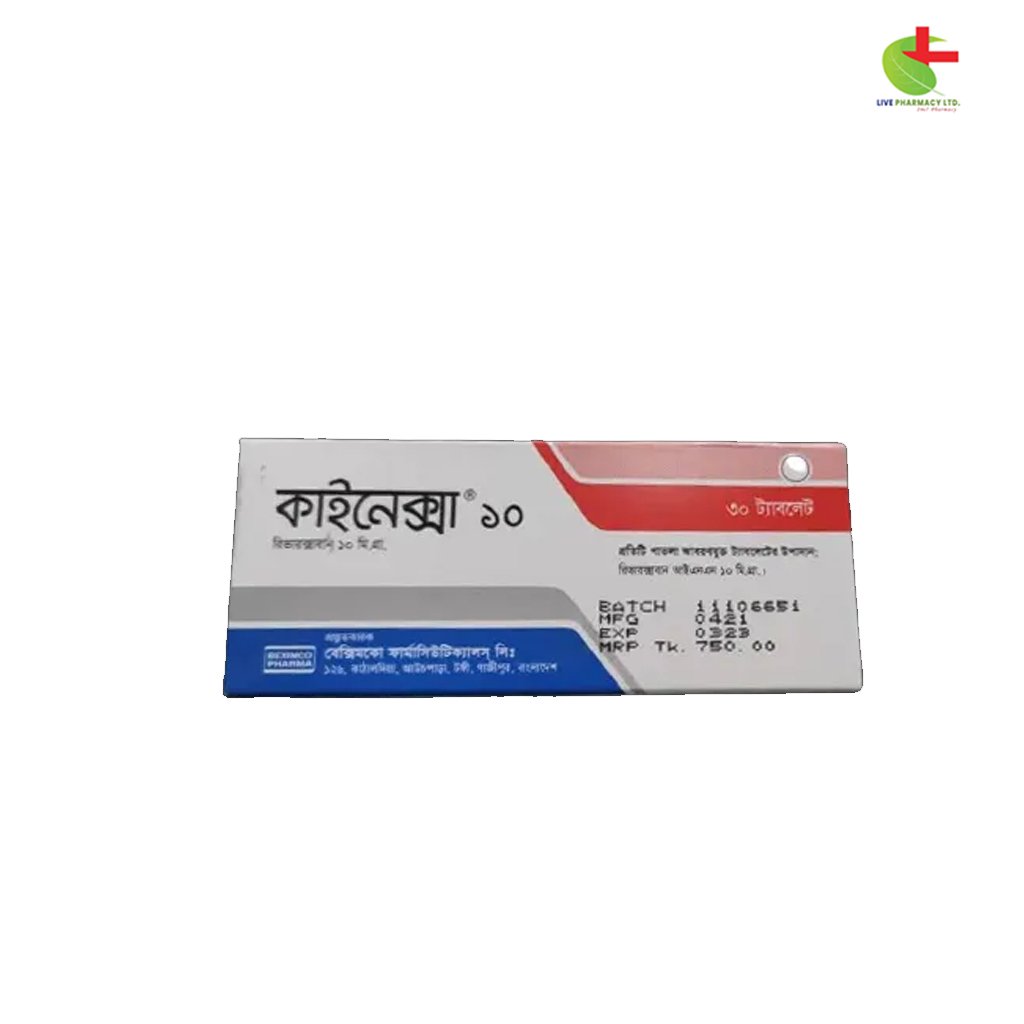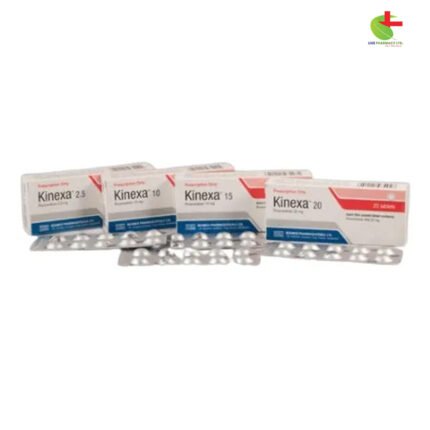Kinexa 10
250.00৳ Strip
- Kinexa is an effective anticoagulant for managing various thromboembolic conditions.
- Formulations: Available in 2.5 mg, 10 mg, and 20 mg doses.
- Indications: Prevents and treats atherothrombotic events after acute coronary syndrome, reduces stroke risk in atrial fibrillation, and manages deep vein thrombosis and pulmonary embolism.
- Active Ingredient: Rivaroxaban, a direct factor Xa inhibitor, prevents clot formation.
- Administration: Proper dosing and monitoring are crucial for maximizing efficacy and minimizing risks.
 Brand
Brand
|
Beximco Pharmaceuticals Ltd |
|---|---|
 Generics
Generics
|
Rivaroxaban |
 Type
Type
|
Tablet |
Indications
Kinexa 2.5 mg is prescribed to prevent atherothrombotic events in adult patients after an Acute Coronary Syndrome (ACS) with elevated cardiac biomarkers. It is used in combination with Aspirin alone or with both Aspirin and Clopidogrel or Ticlopidine.
Kinexa 10-20 mg is indicated to reduce the risk of stroke and systemic embolism in patients with nonvalvular atrial fibrillation. It is also used to treat deep vein thrombosis (DVT) and pulmonary embolism (PE), and to reduce the risk of recurrence of DVT and PE. Additionally, it serves as a prophylactic measure for DVT in patients undergoing knee or hip replacement surgery.
Pharmacology
Kinexa contains Rivaroxaban, a selective direct factor Xa inhibitor. By inhibiting factor Xa, it disrupts the blood coagulation cascade and prevents thrombin formation. Unlike gamma-aminobutyric acid (GABA), Rivaroxaban does not bind to GABAA, GABAB, or benzodiazepine receptors.
Dosage & Administration
For Rivaroxaban 2.5 mg, the recommended dosage is 2.5 mg twice daily, in conjunction with a daily dose of 75-100 mg Aspirin or 75-100 mg Aspirin plus either 75 mg Clopidogrel or a standard daily dose of Ticlopidine.
For Rivaroxaban 10-20 mg:
- Nonvalvular Atrial Fibrillation: For patients with Creatinine Clearance greater than 50 mL/min, the dose is 20 mg orally once daily with the evening meal. For patients with Creatinine Clearance between 15-50 mL/min, the dose is 15 mg orally once daily with the evening meal.
- Treatment of DVT & PE: Begin with 15 mg orally twice daily with food for the first 21 days. Afterward, continue with 20 mg orally once daily with food.
- Prevention of Recurrence of DVT and PE: 20 mg once daily with food.
- Prophylaxis of DVT Following Hip Replacement Surgery: 10 mg once daily for 35 days.
- Prophylaxis of DVT Following Knee Replacement Surgery: 10 mg once daily for 12 days.
The medication may be taken with or without food. When switching from capsules to extended-release, adjust dosage according to the conversion guidelines.
Interactions
Concomitant use with drugs that are combined P-gp and CYP3A4 inhibitors (e.g., ketoconazole, ritonavir) should be avoided as it can increase Kinexa exposure and effects. Avoid also strong CYP3A4 inducers (e.g., rifampicin) as they decrease Kinexa efficacy. Be cautious when using other medications like anti-platelet agents, heparin, and NSAIDs due to an increased risk of bleeding.
Contraindications
Kinexa is contraindicated in patients with hypersensitivity to Rivaroxaban or any of its components, as well as in those with active pathological bleeding.
Side Effects
The most common side effects include an increased risk of bleeding, spinal or epidural hematoma, and a higher risk of stroke after discontinuation, particularly in patients with nonvalvular atrial fibrillation.
Pregnancy & Lactation
Rivaroxaban is classified as a pregnancy category C drug. There are no adequate studies in pregnant women, and its safety during pregnancy has not been established. It is unknown whether Rivaroxaban is excreted in human milk, so breastfeeding is not recommended during treatment.
Precautions & Warnings
Early discontinuation of Kinexa without adequate alternative anticoagulation may increase the risk of thrombotic events. It also raises the risk of bleeding, particularly in patients with bleeding disorders, severe arterial hypertension, gastrointestinal diseases, or a history of pulmonary bleeding. Patients should be monitored for neurological symptoms if undergoing neuraxial anesthesia or spinal puncture.
Overdose Effects
In case of overdose, symptoms may include hemorrhage. There is no specific antidote for Kinexa; however, activated charcoal can be used to reduce absorption. Plasma products may help partially reverse anticoagulation effects.
Therapeutic Class
Kinexa belongs to the class of oral anticoagulants.
Storage Conditions
Store Kinexa in a cool, dry place below 30°C, protected from light. Keep it out of reach of children.













Reviews
There are no reviews yet.